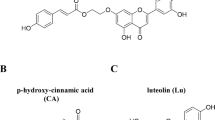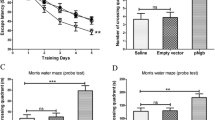Abstract
Elevated β-amyloid (Aβ) is a hallmark of Alzheimer’s disease (AD). Recent evidence has suggested that the receptor of advanced glycation end products (RAGE) is a key target for Aβ-induced perturbation in AD, and blockade of RAGE significantly alleviates synaptic injury. Our previous study has suggested that β-asarone could reduce neuronal apoptosis and improve memory deficits in β-amyloid precursor protein and presenilin-1 (APP/PS1) double transgenic AD-model mice. In the present study, we evaluated the effects of β-asarone on amyloidosis in APP/PS1 mice. We found that the survival of neurons of APP/PS1 mice was improved by β-asarone, meanwhile, β-asarone decreased Aβ deposition and down-regulated Aβ1–42 levels in cortex and hippocampus of APP/PS1 mice brain. Interestingly, the level of RAGE was also significantly down-regulated by β-asarone. Our findings suggest that β-asarone might be effective for the treatment of AD, and the decreasing effects of β-asarone on Aβ might associate with its down-regulation of RAGE.




Similar content being viewed by others
References
Agostinho P, Cunha RA, Oliveira C (2010) Neuroinflammation, oxidative stress and the pathogenesis of Alzheimer’s disease. Curr Pharm Des 16(25):2766–2778
Arancio O, Zhang HP, Chen X, Lin C, Trinchese F, Puzzo D, Liu S, Hegde A, Yan SF, Stern A, Luddy JS, Lue LF, Walker DG, Roher A, Buttini M, Mucke L, Li W, Schmidt AM, Kindy M, Hyslop PA, Stern DM, Du Yan SS (2004) RAGE potentiates Abeta-induced perturbation of neuronal function in transgenic mice. EMBO J 23(20):4096–4105. doi:10.1038/sj.emboj.7600415
Arendt T (2009) Synaptic degeneration in Alzheimer’s disease. Acta Neuropathol 118(1):167–179. doi:10.1007/s00401-009-0536-x
Casadesus G, Smith MA, Zhu X, Aliev G, Cash AD, Honda K, Petersen RB, Perry G (2004) Alzheimer disease: evidence for a central pathogenic role of iron-mediated reactive oxygen species. J Alzheimers Dis 6(2):165–169
Chen X, Walker DG, Schmidt AM, Arancio O, Lue LF, Yan SD (2007) RAGE: a potential target for Abeta-mediated cellular perturbation in Alzheimer’s disease. Curr Mol Med 7(8):735–742
Deane R, Du Yan S, Submamaryan RK, LaRue B, Jovanovic S, Hogg E, Welch D, Manness L, Lin C, Yu J, Zhu H, Ghiso J, Frangione B, Stern A, Schmidt AM, Armstrong DL, Arnold B, Liliensiek B, Nawroth P, Hofman F, Kindy M, Stern D, Zlokovic B (2003) RAGE mediates amyloid-beta peptide transport across the blood-brain barrier and accumulation in brain. Nat Med 9(7):907–913. doi:10.1038/nm890
Dudal S, Krzywkowski P, Paquette J, Morissette C, Lacombe D, Tremblay P, Gervais F (2004) Inflammation occurs early during the Abeta deposition process in TgCRND8 mice. Neurobiol Aging 25(7):861–871. doi:10.1016/j.neurobiolaging.2003.08.008
Fan R, Xu F, Previti ML, Davis J, Grande AM, Robinson JK, Van Nostrand WE (2007) Minocycline reduces microglial activation and improves behavioral deficits in a transgenic model of cerebral microvascular amyloid. J Neurosci 27(12):3057–3063. doi:10.1523/jneurosci.4371-06.2007
Fang F, Lue LF, Yan S, Xu H, Luddy JS, Chen D, Walker DG, Stern DM, Yan S, Schmidt AM, Chen JX, Yan SS (2010) RAGE-dependent signaling in microglia contributes to neuroinflammation, Abeta accumulation, and impaired learning/memory in a mouse model of Alzheimer’s disease. FASEB J 24(4):1043–1055. doi:10.1096/fj.09-139634
Fang YQ, Shi C, Liu L, Fang RM (2012) Pharmacokinetics of beta-asarone in rabbit blood, hippocampus, cortex, brain stem, thalamus and cerebellum. Pharmazie 67(2):120–123
Geng Y, Li C, Liu J, Xing G, Zhou L, Dong M, Li X, Niu Y (2010) Beta-asarone improves cognitive function by suppressing neuronal apoptosis in the beta-amyloid hippocampus injection rats. Biol Pharm Bull 33(5):836–843
Huang C, Li WG, Zhang XB, Wang L, Xu TL, Wu D, Li Y (2013) Alpha-asarone from Acorus gramineus alleviates epilepsy by modulating A-type GABA receptors. Neuropharmacology 65:1–11
Kitamura Y, Shimohama S, Kamoshima W, Ota T, Matsuoka Y, Nomura Y, Smith MA, Perry G, Whitehouse PJ, Taniguchi T (1998) Alteration of proteins regulating apoptosis, Bcl-2, Bcl-x, Bax, Bak, Bad, ICH-1 and CPP32, Alzheimer’s disease. Brain Res 780(2):260–269
Kurt MA, Davies DC, Kidd M, Duff K, Rolph SC, Jennings KH, Howlett DR (2001) Neurodegenerative changes associated with beta-amyloid deposition in the brains of mice carrying mutant amyloid precursor protein and mutant presenilin-1 transgenes. Exp Neurol 171(1):59–71. doi:10.1006/exnr.2001.7717
Kurz A, Perneczky R (2011) Amyloid clearance as a treatment target against Alzheimer’s disease. J Alzheimers Dis 24(Suppl 2):61–73. doi:10.3233/jad-2011-102139
Lee B, Sur B, Shim YM, Lee I, Hahm DH (2014) Alpha-Asarone, a Major Component of Acorus gramineus, Attenuates Corticosterone-Induced Anxiety-Like Behaviours via Modulating TrkB Signaling Process. Korean J Physiol Pharmacol 18(3):191–200
Liu J, Li C, Xing G, Zhou L, Dong M, Geng Y, Li X, Li J, Wang G, Zou D, Niu Y (2010) Beta-asarone attenuates neuronal apoptosis induced by Beta amyloid in rat hippocampus. Yakugaku Zasshi 130(5):737–746
Lu H, Li J, Li M, Gong T, Zhang Z (2014) Systemic delivery of alpha-asarone with Kolliphor HS 15 improves its safety and therapeutic effect on asthma. Drug Deliv. doi:10.3109/10717544.2014.889776
Lue LF, Walker DG, Brachova L, Beach TG, Rogers J, Schmidt AM, Stern DM, Yan SD (2001) Involvement of microglial receptor for advanced glycation end products (RAGE) in Alzheimer’s disease: identification of a cellular activation mechanism. Exp Neurol 171(1):29–45. doi:10.1006/exnr.2001.7732
McKhann G, Drachman D, Folstein M, Katzman R, Price D, Stadlan EM (1984) Clinical diagnosis of Alzheimer’s disease: report of the NINCDS-ADRDA Work Group under the auspices of Department of Health and Human Services Task Force on Alzheimer’s Disease. Neurology 34(7):939–944
Morgan D, Gordon MN, Tan J, Wilcock D, Rojiani AM (2005) Dynamic complexity of the microglial activation response in transgenic models of amyloid deposition: implications for Alzheimer therapeutics. J Neuropathol Exp Neurol 64(9):743–753
Neeper M, Schmidt AM, Brett J, Yan SD, Wang F, Pan YC, Elliston K, Stern D, Shaw A (1992) Cloning and expression of a cell surface receptor for advanced glycosylation end products of proteins. J Biol Chem 267(21):14998–15004
Origlia N, Righi M, Capsoni S, Cattaneo A, Fang F, Stern DM, Chen JX, Schmidt AM, Arancio O, Yan SD, Domenici L (2008) Receptor for advanced glycation end product-dependent activation of p38 mitogen-activated protein kinase contributes to amyloid-beta-mediated cortical synaptic dysfunction. J Neurosci 28(13):3521–3530. doi:10.1523/jneurosci.0204-08.2008
Origlia N, Capsoni S, Cattaneo A, Fang F, Arancio O, Yan SD, Domenici L (2009) Abeta-dependent Inhibition of LTP in different intracortical circuits of the visual cortex: the role of RAGE. J Alzheimers Dis 17(1):59–68. doi:10.3233/jad-2009-1045
Padurariu M, Ciobica A, Mavroudis I, Fotiou D, Baloyannis S (2012) Hippocampal neuronal loss in the CA1 and CA3 areas of Alzheimer’s disease patients. Psychiatr Danub 24(2):152–158
Schmidt AM, Yan SD, Yan SF, Stern DM (2000) The biology of the receptor for advanced glycation end products and its ligands. Biochim Biophys Acta 1498(2–3):99–111
Shimizu S, Narita M, Tsujimoto Y (1999) Bcl-2 family proteins regulate the release of apoptogenic cytochrome c by the mitochondrial channel VDAC. Nature 399(6735):483–487. doi:10.1038/20959
Su J, Zhu W, Liu J, Yin J, Qin W, Jiang C (2014) The involvement of neuronal nitric oxide synthase in antiepileptic action of alpha-asarone on pentylenetetrazol molding rats. Biomed Mater Eng 24(6):3645–3655
Sun A, Nguyen XV, Bing G (2002) Comparative analysis of an improved thioflavin-s stain, Gallyas silver stain, and immunohistochemistry for neurofibrillary tangle demonstration on the same sections. J Histochem Cytochem 50(4):463–472
Trinchese F, Liu S, Battaglia F, Walter S, Mathews PM, Arancio O (2004) Progressive age-related development of Alzheimer-like pathology in APP/PS1 mice. Ann Neurol 55(6):801–814
Wei G, Chen YB, Chen DF, Lai XP, Liu DH, Deng RD, Zhou JH, Zhang SX, Li YW, Lii H, Liu LF, Wang Q, Nie H (2013) beta-Asarone inhibits neuronal apoptosis via the CaMKII/CREB/Bcl-2 signaling pathway in an in vitro model and AbetaPP/PS1 mice. J Alzheimers Dis 33(3):863–880. doi:10.3233/jad-2012-120865
Yan SD, Yan SF, Chen X, Fu J, Chen M, Kuppusamy P, Smith MA, Perry G, Godman GC, Nawroth P et al (1995) Non-enzymatically glycated tau in Alzheimer’s disease induces neuronal oxidant stress resulting in cytokine gene expression and release of amyloid beta-peptide. Nat Med 1(7):693–699
Yan SD, Chen X, Fu J, Chen M, Zhu H, Roher A, Slattery T, Zhao L, Nagashima M, Morser J, Migheli A, Nawroth P, Stern D, Schmidt AM (1996) RAGE and amyloid-beta peptide neurotoxicity in Alzheimer’s disease. Nature 382(6593):685–691. doi:10.1038/382685a0
Yan SD, Bierhaus A, Nawroth PP, Stern DM (2009) RAGE and Alzheimer’s disease: a progression factor for amyloid-beta-induced cellular perturbation? J Alzheimers Dis 16(4):833–843
Yan SS, Chen D, Yan S, Guo L, Du H, Chen JX (2012) RAGE is a key cellular target for Abeta-induced perturbation in Alzheimer’s disease. Front Biosci 4:240–250
Zlokovic BV (2008) New therapeutic targets in the neurovascular pathway in Alzheimer’s disease. Neurotherapeutics 5(3):409–414. doi:10.1016/j.nurt.2008.05.011
Zou DJ, Wang G, Liu JC, Dong MX, Li XM, Zhang C, Zhou L, Wang R, Niu YC (2011) Beta-asarone attenuates beta-amyloid-induced apoptosis through the inhibition of the activation of apoptosis signal-regulating kinase 1 in SH-SY5Y cells. Pharmazie 66(1):44–51
Acknowledgments
This work was supported by the National Major Science and Technology for Special Program of Creative Drug of China (2009ZX09103-429), the Doctoral Fund of Education Ministry of China (Nos. 20114425110007, 20134425110003), the Scientific and Technical innovation Project of Guangdong Provincial Education Department of China (2012KJCX0032), South China Chinese Medicine Collaborative Innovation Center (No. A1-AFD01514A05), and the Characteristic Key Discipline Construction Fund of Chinese Internal Medicine of Guangzhou University of Chinese Medicine (2013–2015).
Conflict of interest
The authors declare that there is no conflict of interest.
Author information
Authors and Affiliations
Corresponding authors
Additional information
Cong Yang, Xiaoguang Li have contributed equally to this work.
Rights and permissions
About this article
Cite this article
Yang, C., Li, X., Mo, Y. et al. β-Asarone Mitigates Amyloidosis and Downregulates RAGE in a Transgenic Mouse Model of Alzheimer’s Disease. Cell Mol Neurobiol 36, 121–130 (2016). https://doi.org/10.1007/s10571-015-0226-2
Received:
Accepted:
Published:
Issue Date:
DOI: https://doi.org/10.1007/s10571-015-0226-2




